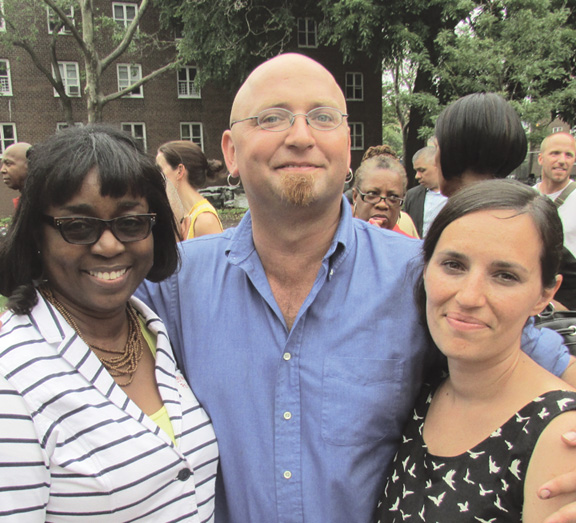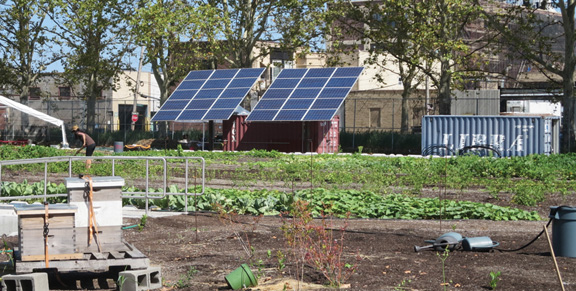Under the leadership of Ian Marvy, the Red Hook Community Farm has been a recognized pioneer in the urban farming movement. The farm has been a community hub for nearly fifteen years, providing educational programs, service learning sessions, and partnering with dozens of organizations in the neighborhood and citywide. But in 2012, the seawater that Sandy threw over Red Hook, damaged the farm as well, almost fatally. With the help of disaster relief funds, the farm is operating, but is still recovering. Adding to that disaster, Marvy has stepped down as Executive Director earlier this year. The circumstances of that are unclear, but the first job handed to interim executive director Dart Westphal is the restoration of Added Value’s non profit legal status.

Leadership in transition
Caleb Crawford, a CSA Core Member, spoke about the serious implications of losing Marvy and the gaps that now have to be filled. “There’s institutional knowledge we just don’t have,” he said.
There hasn’t been much outreach during this interim period. Restaurants on Van Brunt Street, have been left out of the loop. They lament not receiving a share of the harvest since Sandy. Not that this has left bad blood. Sohui Kim, chef and restaurateur of the Good Fork, looks forward to the day when the farm is back on its feet and its vegetables are back on their menu.
But the lack of transparency has left partners close to the inner circle wondering what’s in store for this year. And with the major transition in leadership, that is something of an open question.
Assemblyman Felix Ortiz, who has helped the farm receive NY State grants over the years, praised Marvy’s leadership. “He was always involved, always called me… We had a very good relationship.”
The change in leadership doesn’t perturb the Assemblyman. “I look forward to continuing the same relationship with the new executive director, whomever they choose.”
The farm is still operating, giving local youth summer jobs, as in years past. On a recent busy Saturday, Corey Blant, Youth Empowerment Coordinator, spoke about the farm. “The kids did all this. I mean, the city built the concrete walls, but the kids built the beds,” and with a staff of only 14 teenagers, the football field sized garden is a considerable achievement.
David Buckel, the Compost Coordinator, gave a current diagnosis of the farm, which as in much or Red Hook begins with Sandy. The hurricane rocked the field, flooding several feet, submerging everything that couldn’t float and crashing what it picked up against the chain link fence bordering Sigourney Street.

Sandy damage devastating
“I collapsed right there in the middle of the rows,” Buckel says, almost choking up when recalling his first impression of the devestation. “The soil was so salty afterwards we couldn’t grow weeds.”
But, as wrenching a blow as the storm was to this center of community, the restoration efforts afterwards held that center. Youth involvement had more work than ever to do, and with substantial investment from the city, they have been able to remake the farm in a fashion that better utilizes its space and increases its yield potential.
A 24-inch concrete floodwall was installed, adding soil depth for the plant roots, making tall crops like corn more wind resistant. The community-composting center (now the largest in the city) has a new sifting house powered by two large solar panels planted on the Bay street side, facing the sunrise to the east.

New soil was provided and is in the process of being brought up to a proper acidity level. With last year’s resources being spent almost exclusively on rebuilding infrastructure, this year the farm is able to supply 30 neighborhood families with weekly cartons of produce through their CSA (Community Supported Agriculture).
What they can’t provide they supplement with vegetables from a nearby farm on Long Island, but all the bok choy, basil, turnips, radishes, peppers, and greens are grown right here in Red Hook. They even have two beehive boxes and a pumpkin patch, foreshadowing the Harvest Fair, which is scheduled for October 18.
The new farm structure’s potential yield is promising, and the amount of energy being put into recovery is inspiring. The primary goal of empowering and educating community youth has been maintained. But no one is saying the recovery is complete.
Red Hook local and first-time CSA member of the CSA, Dodo, commented on her experience this year. “They are struggling,” she said, noting she’d received late and incorrect information in some CSA bulletins. As for the produce, she remarked that while it isn’t enough to feed a family, it is a fine nutritional supplement. “The food looks great, but it is not a whole harvest.” Despite this mild criticism, she’s noted that she does see organized action.
Despite the dual setbacks of Sandy and the Marvy’s loss, everyone anticipates next year to be one of greater success. Through the use of organic sulfur, the new soil’s pH level will be cultivated back to its pre-Sandy state. Better soil means more production and that means expanded CSA and youth involvement. Volunteer and job opportunities still exist – for more information stop by the farm, which is right by IKEA, any Saturday morning.
For information on becoming a member of the CSA, go to www.redhookcsa.com.










